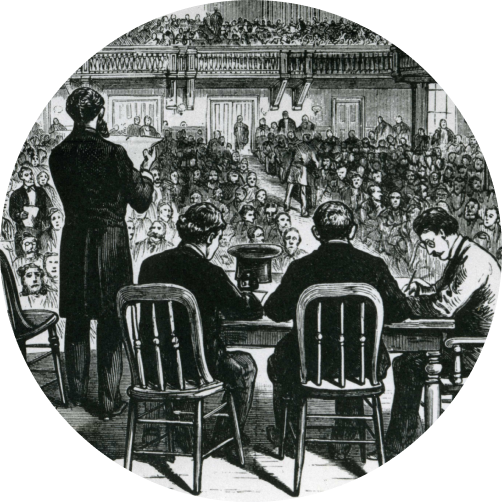Banding together
In 1873, the United States faced a financial panic that led to one of the worst recessions in its history. Unemployment and bankruptcies surged, and 300 banks failed. Amid this turmoil, bankers began informally exchanging ideas, supporting one another and sharing strategies.


But the real turning point came from an unexpected source—the women’s suffrage movement. In St. Louis, two young bankers were inspired by the power of collective action they saw at a suffrage meeting.
They realized that bankers could also come together to accomplish more. The idea gained momentum, and in July 1875, 349 bankers from 31 states and the District of Columbia gathered in Saratoga Springs, New York, to form the American Bankers Association. It remains the only association that represents banks of all sizes, charters and business models.
Protecting Americans’ money
In the days before deposit insurance or modern policing, one big challenge was how to safeguard bank funds. Bank robberies were a persistent problem.

Recognizing the power of collective action, ABA offered rewards of up to $1,000 for information that led to the capture of bank thieves and vowed to track down robbers.
During 1896-97, the only successful robbery of an ABA member bank happened because the bank's ABA membership sign wasn’t visible to the robbers. In 1894, ABA hired the Pinkerton National Detective Agency to monitor criminals and alert members about their movements. This partnership proved highly effective, doubling ABA’s membership. The Pinkertons worked with ABA for 15 years, famously tracking down Butch Cassidy’s “Wild Bunch” gang in 1902.
Making money move easier
Stopping bank robbers wasn’t the only milestone banks achieved through collaboration. In 1911, ABA introduced the routing number, giving each bank a unique numeric identifier.
This innovation laid the groundwork for efficient nationwide payment processing. More breakthroughs followed.


In 1956, ABA approved the use of magnetic ink character recognition to streamline check processing, and in 1974, ABA co-founded Nacha to coordinate automated payment clearing. In 1967, ABA created the CUSIP system, a unique identifier for securities that became a global standard. These standards and technologies remain the backbone of today’s banking infrastructure.
ABA continues to shape the future by developing standards like the .bank domain to provide a secure online space for financial institutions.
A Foundation to build on
ABA's commitment to education began in the 1920s with the launch of programs that provided textbooks and sample lectures, helping bankers teach economics and banking in public schools.


In 1925, to mark its 50th anniversary, ABA established an Educational Foundation, supported by a $500,000 endowment, which funded economic research at various colleges.
Now celebrating its 100th anniversary, the ABA Foundation continues to have significant influence. It provides resources that help bankers deliver financial education, support the development of affordable housing, protect seniors from fraud, and much more. Through the collective dedication of banker volunteers, the Foundation remains a vital force in promoting financial wellness and community well-being.
Putting heads together at Stonier
From its inception, ABA has been a vital space for bankers to connect, share information, and enhance their skills. The American Institute of Bank Clerks played a key role in providing continuing education, empowering banks’ professional staff to advance in their careers.


In 1935, ABA further solidified its commitment to education by establishing the ABA Graduate School of Banking, which welcomed 220 students.
Now located at the University of Pennsylvania, the school’s name honors Harold Stonier, the former ABA chief executive who initiated the program. Today, it continues to cultivate the next generation of banking leaders, ensuring that bankers are well-equipped to navigate the evolving financial landscape.
Bankers at war
From World War I to the present, bankers have worked through ABA to support soldiers fighting overseas. During World War I, ABA conducted five Liberty Loan drives that raised over $21.4 million.


During World War II, ABA stepped up in a bigger way, encouraging banks to lend for war production purposes and helping banks finance military operations through bank purchases of government bonds.
Following the 9/11 attacks, bankers once again stepped up to the challenge during the War on Terror by implementing anti-money laundering measures and countering the financing of terrorism.
Today, ABA continues this vital mission by providing resources to help bankers combat financial crimes and comply with sanctions, safeguarding the US banking system from bad actors worldwide.
A commitment to community banks
ABA has always been an association committed to community banking. As the banking landscape evolved in the late 20th century, ABA recognized the need to address novel challenges facing America’s community banks.


In response, ABA established a Community Bankers Council in 1981 and, in the late 1980s, introduced new community bank offerings such as ABA Insurance Services and the precursor to today’s ABA Partner Network.
This commitment to community banks has only grown deeper.
In 2018, ABA championed S.2155, which relieved regulatory burdens on smaller banks.
That same year, ABA President Rob Nichols formed a new Core Platforms Committee to address community bank concerns that the major core processing firms were not being responsive to the needs of their smaller bank clients. ABA’s leadership resulted in the development of a set of principles for strong bank-core relationships, which all core providers now agree to uphold.
Advocacy on all fronts
In 1998, ABA achieved a significant victory in the Supreme Court.
The National Credit Union Administration (NCUA) had overstepped its authority, the court ruled, by allowing federal credit unions to admit employee groups beyond the common bond specified in the law.

Although the association typically reserved legal action for exceptional circumstances, the landscape shifted in the 2020s. With regulators adopting excessively broad interpretations of their statutory powers, ABA took decisive action. It didn’t hesitate to file lawsuits aimed at securing regulatory relief and ensuring that agencies adhered to their designated purposes.
A focus on women in banking
The first woman bank president, Louise Weiser, dates to 1875, the same year as ABA. And while women — such as Maggie Walker, who became the first Black woman to start a bank in 1903 — have long been a vital part of banking history, they were underrepresented in bank leadership until recent decades.


A sign of change came in 2004, when Betsy Duke, a community banker from Virginia, was elected ABA’s first woman chair.
Duke has been followed by several more women in ABA leadership, and the association has also been a leader in providing training and educational opportunities for women and men looking for careers in banking.
A new tool to reduce the unbanked
Another landmark in inclusion came in 2015, when the Cities for Financial Empowerment Fund launched the Bank On national account standards for simple, low-cost transaction accounts for those operating outside the banking system. ABA played a crucial role in advancing Bank On.


Between 2020, when ABA President Rob Nichols urged all banks to offer a Bank On-certified account, and 2024, the number of certified accounts skyrocketed by nearly 700%.
As a result, over 97% of low-to-moderate income households gained access to Bank On-certified accounts. In fact, by 2023 — despite a global pandemic and recession — the number of unbanked Americans reached a record low, a positive outcome attributed in part to the collective efforts of ABA members to expand access to essential financial services.
Economic first responders
During the COVID-19 pandemic, bankers supported small businesses after Congress established the Paycheck Protection Program.

As the largest private-sector economic rescue in American history, the PPP provided nearly $800 billion in over 11.8 million loans to small businesses — the vast majority made by bankers.
Many of these dedicated professionals worked tirelessly, often around the clock, to process loan applications and ensure that funds reached businesses in need. Meanwhile, ABA staff also worked diligently, coordinating with the government and communicating late-breaking PPP changes to bankers, ensuring they had the information needed to navigate this extraordinary situation and provide critical support to small businesses.
 The story continues
The story continues










